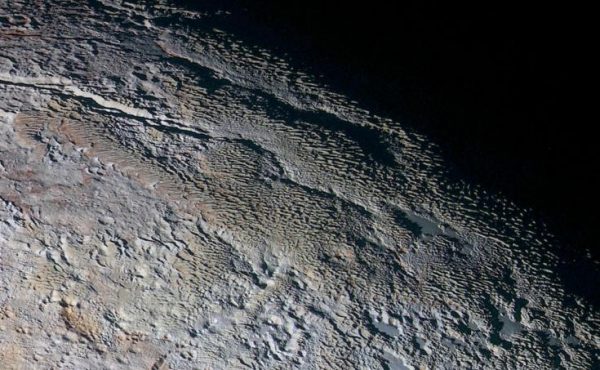York U research identifies icy ridges on Pluto
TORONTO, January 4, 2017 - Using a model similar to what meteorologists use to forecast weather on Earth and a computer simulation of the physics of evaporating ices, a new study, published in the journal Nature, by York University’s Professor John Moores, Department of Earth and Space Science and Engineering at York’s Lassonde School of Engineering, has found evidence that snow and ice features previously only seen on Earth, have been spotted on Pluto.
“Penitentes” which are formed by erosion, are bowl-shaped depressions with spires around the edge, and are several metres high.
The groundbreaking research, done in collaboration with researchers at NASA and Johns Hopkins University, indicates that these icy features may exist on other planets where environmental conditions are similar.
“The identification of the ridges of Tartarus Dorsa as Penitentes suggests that the presence of an atmosphere is necessary for the formation of penitentes, which would explain why they have not previously been seen on other airless icy satellites or dwarf planets,” says Moores. “But exotic differences in the environment give rise to features with very different scales. This test of our terrestrial models for penitentes suggests that we may find these features elsewhere in the solar system, and in other solar systems, where the conditions are right."
Moores, along with his York postgraduate fellow, Dr. Christina Smith, Dr. Anthony Toigo, at the Applied Physics Laboratory, Johns Hopkins University and NASA Research Astrophysicist, Dr. Scott D. Guzewich, at the Goddard Space Flight Center in Maryland, USA compared their model to ridges on Pluto imaged by the New Horizons spacecraft in 2015. Pluto’s ridges are much larger - 500 metres tall and separated by three to five kilometres - as compared to their meter-sized earthly counterparts.

Photo Credit: NASA/Johns Hopkins University Applied Physics Laboratory/Southwest Research Institute
“This gargantuan size is predicted by the same theory that explains the formation of these features on Earth,” says Moores. “In fact, we were able to match the size and separation, the direction of the ridges, as well as their age: three pieces of evidence that support our identification of these ridges as penitentes.”
Moores says though Pluto's environment is very different from the Earth - it is much colder, the air much thinner, the sun much dimmer and the snow and ice on the surface are made from methane and nitrogen instead of water - the same laws of nature apply. Both NASA and Johns Hopkins University were instrumental in the collaboration that led to this new finding. Both provided background information on Pluto's atmosphere using a model similar to what meteorologists use to forecast weather on Earth. This was one of the key ingredients in Moores’ own models of the penitentes, without which this discovery would not have been made.
York University is known for championing new ways of thinking that drive teaching and research excellence. Our students receive the education they need to create big ideas that make an impact on the world. Meaningful and sometimes unexpected careers result from cross-discipline programming, innovative course design and diverse experiential learning opportunities. York students and graduates push limits, achieve goals and find solutions to the world’s most pressing social challenges, empowered by a strong community that opens minds. York U is an internationally recognized research university – our 11 faculties and 26 research centres have partnerships with 200+ leading universities worldwide. Located in Toronto, York is the third largest university in Canada, with a strong community of 53,000 students, 7,000 faculty and administrative staff, and more than 295,000 alumni. York U's fully bilingual Glendon campus is home to Southern Ontario's Centre of Excellence for French Language and Bilingual Postsecondary Education.
Media contact:
Anjum Nayyar, Media Relations, 416 736 2100 ext. 44543, anayyar@yorku.ca.






